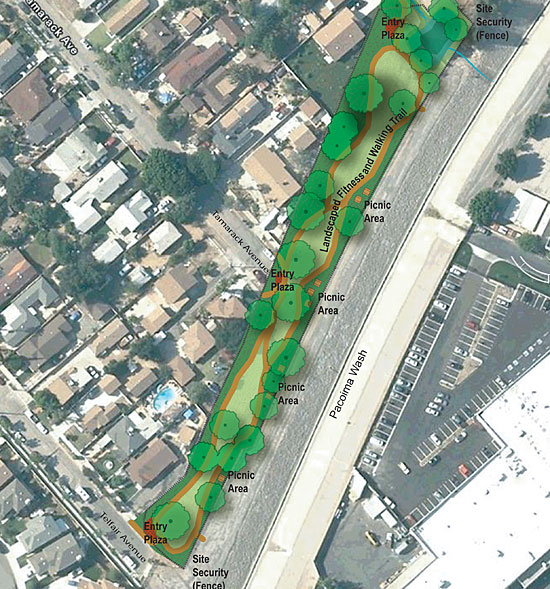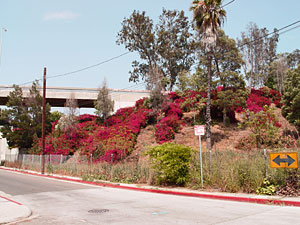Top Story: Health
This Thanksgiving, less can be more
November 16, 2012

The turkey's stuffed, but you don't have to be. The director of Public Health has tips for taking it easy at the table.
So your belt buckle is loosened, your appetite is whetted and your fat pants are pressed and ready to go. But for all you pilgrims who yearn for a Turkey Day that, just once, could go easier on your waistline, Los Angeles County’s director of public health has a gentle suggestion:
“Choose less,” says Dr. Jonathan E. Fielding. “Thanksgiving isn’t just about the meal.”
Fielding’s advice echoes the motto of the recent Department of Public Health campaign to educate Southern Californians about portion control. Most adults only need 2,000 calories a day to remain healthy, and most children require even fewer. But many Americans bust that caloric budget and then some on Thanksgiving, typically packing 2,000 to 5,000 calories into a single meal, says Fielding.
“This is a day when it’s not surprising to see somebody go a little crazy,” he says. “There are, however, a couple of things you can do that may be palatable.”
Try to have an active morning. “Do a little extra exercise,” Fielding suggests. A 30-minute jog (about three miles) will work off about six ounces of turkey. Sixty sets of 10 Burpees, and it will be as if you never ate that cup of mashed potatoes and gravy. And if you get really ambitious, 20 minutes on the stairs or Stairmaster will dispense with a slice of pumpkin pie.
Don’t hit the table on an empty stomach. “Eat a piece of fruit or a handful of nuts before heading out to your gathering,” Fielding says. “Or drink a couple of glasses of water to give yourself that feeling of fullness.” Being less hungry will help you avoid overeating when you sit down to the main meal.
Set the table with smaller dishes. Use plates that are 8-10 inches for adults and 6-8 inches for kids, Fielding says. It helps your guests control their portions, and acknowledges the tendency of most people to clean their plates, even if they already feel full.
Take the serving dishes off the table. “When food is in front of us, we tend to eat it,” says Fielding. “So put the serving dishes on another table, or in another room, where you’re not looking at them.”
Start with small portions. “Just serve yourself two to four bites of whatever looks good,” Fielding suggests. “Eat slowly, and give your body a chance to enjoy what you’ve swallowed. Give yourself 20 minutes, and then, if you’re still hungry, go back.” Remember that standard portions of most foods are much smaller than the super-sized menus doled out in restaurants, and an ideal plate should be half vegetables and fruit. (Click here for a good primer.) A standard serving of poultry is 3 ounces, about the size of a deck of cards; a standard serving of mashed potatoes should be about the size of a tennis ball.
Hydrate. Water is one of the best beverages around, Fielding notes, and, for a Thanksgiving dinner, sparkling water couldn’t be more elegant. Even if you’re serving wine or cider, make sure it’s on the table as an alternative.
Please don’t serve sugary sodas, especially not to the kids. Q: What has the equivalent of 22 packets of sugar in it, and more calories than a second helping of stuffing? A: A 20-ounce bottle of regular Coke. Fielding says that, of all the efforts Americans make to keep their weight down, just three simple changes would make a world of difference. “Choose less, increase physical activity and reduce your intake of sugar sweetened beverages.” A single serving a day of sugar-sweetened beverages increases a child’s risk of obesity by 60 percent.
Embrace leftovers—but not for too long. Leftovers, of course, are one of the best things about Thanksgiving dinner. They’re also a good way to talk yourself out of overeating. Have your guests bring their own takeaway containers. Or, if you’re a guest, think about setting aside part of your meal to take home and eat later. Just remember that food shouldn’t sit out for more than two hours, says Fielding. Unlike fat pants, “leftovers don’t have an infinite life.”
Posted 11/15/12
Condom measure heads to the ballot
August 9, 2012

In spite of wide-ranging concerns, a measure to require condoms on porn shoots will go before voters.
An initiative to mandate condom use in adult film production moved this week to the November ballot, despite predictions that it could expose the county to lawsuits and leave taxpayers picking up the tab for some of the program’s costs.
The measure also raises potential free speech questions; compelling filmmakers to put condoms in their movies could be construed as an infringement of the First Amendment.
Acknowledging concerns about the measure, the Board of Supervisors voted to 3-1-1 Tuesday to place it on the ballot, after supporters gathered enough signatures to easily qualify it earlier this month. Supervisor Gloria Molina voted no and Supervisor Mark Ridley-Thomas abstained.
“We’re all in favor of porno stars using condoms,” Molina said, “but the issue is liability for the county.” Molina noted that existing law requires the state, not the counties, to enforce workplace safety, and said that the county already pays out more than $100 million a year in liability claims.
Backed by Los Angeles AIDS activists, the ballot measure would require the county to issue and enforce public health and film permits for porn producers, whose performers would have to use condoms on their sets. Violators could be fined and/or charged with misdemeanors.
The initiative addresses longstanding concerns about unsafe sex in the San Fernando Valley’s burgeoning porn industry, and qualified for the ballot with more than 370,000 signatures.
It has been dogged, however, by concerns about jurisdiction and enforcement. Workplace safety in California is currently regulated by federal and state law and enforced by Cal/OSHA. And most adult films are shot quickly and without permits, often in private homes and garages, which makes it hard to police them.
Those concerns were echoed in reports from the Department of Public Health and County Counsel. The Public Health analysis noted that, unlike, say, catering truck owners, adult film producers rarely disclose their locations in advance, and their competitors rarely know enough about their procedures to notify the county of suspected violations. Thus, even with laws in place, it would be difficult to protect many if not most adult film performers.
Meanwhile, County Counsel John Krattli noted that if the initiative passes, the county would be vulnerable to lawsuits, not only from the measure’s backer, AIDS Healthcare Foundation, which could sue if enforcement fails, but also from the adult industry, whose lawyers confirmed the threat on Tuesday.
“This is an unconstitutional and unwise attempt to fix a nonexistent problem,” said Allan Gelbard, a First Amendment lawyer. “What’s it going to cost the county if you enact it and you are sued and lose? . . . I believe the county would be on the hook.”
Although the measure would require the adult film industry to foot the bill for the enforcement, the Public Health analysis found “significant” startup costs attached to the measure that are unlikely to be covered by the permitting fees built into the initiative because so few adult film producers bother to apply for permits.
Among other things, the report noted, the county would have to set up training programs for producers, create a permitting and review process, maintain an industry database, conduct regular inspections and spot checks, staff a complaint line, assess fines and administer appeals.
The establishment of an Adult Film Public Health Permit Office would cost at least $291,466 a year, not including the costs of confiscation, law enforcement and evidence warehousing, the report said.
“If 10 public health permits were issued, the two-year costs translate into a fee of $58,294 per permit,” the report noted. Even if 50 adult film producers were to apply for permits, the per-permit fee would still be more than $11,000.
Advocates for the measure insisted, however, that it is necessary for porn performers to be ensured of a safe workplace.
Posted 7/24/12
Will new condom law make porn safer?
July 10, 2012
 Few health issues are as obvious—or as guaranteed to generate headlines—as unsafe sex in L.A.’s booming adult film industry. But as an initiative requiring the use of condoms during porn shoots moves closer to the November ballot, it has become equally clear that, if it passes, the county would face a daunting challenge.
Few health issues are as obvious—or as guaranteed to generate headlines—as unsafe sex in L.A.’s booming adult film industry. But as an initiative requiring the use of condoms during porn shoots moves closer to the November ballot, it has become equally clear that, if it passes, the county would face a daunting challenge.
“This will be very difficult to enforce,” said the director of the county Department of Public Health, Dr. Jonathan E. Fielding. “If it passes, we’re going to do the best we can, and get the best ideas from everywhere, but there are some serious issues involved in this.”
Members of the Board of Supervisors on Tuesday delayed certifying the initiative for the November ballot until July 24. They asked for a report on the impact on the county, which would be required to enforce the law if enacted.
Backed by Los Angeles AIDS activists, the measure aims to address a chronic health hazard in the nation’s porn capital, where adult entertainment actors fear losing their audiences or jobs if they refuse to perform without condoms. At least three highly publicized industry HIV outbreaks have occurred since the late 1990s.
But the initiative also resurrects quandaries that have long vexed health advocates: How do you regulate a workplace that largely operates under the radar? And how much of the county’s limited health resources should go to a niche that generates only about 1.5% of all its sexually transmitted diseases?
“The nature of the industry is elusive,” said Mario Perez, director of the public health department’s Division of HIV and STD Programs. “Film shoots happen in folks’ living rooms and backyards. They’re scattered throughout the county, without fixed addresses.”
A 2009 report to the Board of Supervisors estimated that Los Angeles County had some 200 porn production companies, with about 1,200 workers engaging in direct, work-related sexual contact, mostly on unpermitted shoots that lasted only a few hours. And, health officials point out, unlike, say, a restaurant, where a kitchen either is sanitary or it isn’t, every act is a fresh opportunity for infection.
“In the most robust sense,” Perez said, “this initiative could mean that we would have to observe every sex scene in every adult film produced in Los Angeles County.”
During Tuesday’s meeting, Supervisor Zev Yaroslavsky echoed those concerns, saying that an unenforceable law would be “a mockery from the starter’s gate.”
“We need to figure out a way to make this stick,” he said, “and not just be a chapter in the municipal code that sits there as a symbol.”
L.A. porn has been both an economic engine and an intractable frustration. State and federal laws require employers to protect workers from potentially infectious bodily fluids, and Cal/OSHA has jurisdiction over workplace hazards—as the county has long argued. The state contends, however, that its resources are tight and employment complaints rarely arise from porn sets, where most performers are hired as independent contractors, not employees.
For years, the industry said it was policing itself through a screening database maintained by a nonprofit industry clinic, but HIV outbreaks in 1998, 2004 and 2009 fueled fears. In 2010, amid complaints and litigation from the AIDS Healthcare Foundation, which backed the current initiative, the county shut down the clinic for operating without a license, heightening awareness but eliminating one of the few checks on the industry.
The county has called for tougher state laws and reported suspected violations to Cal/OSHA. But local health officials have maintained that they have neither the resources nor the jurisdiction to become Los Angeles’ porn police.
Though the industry has generated thousands of STD and HIV cases over the years, the porn problem is dwarfed by other at-risk populations. The adult film industry has accounted for fewer than 20 of the more than 20,000 cases of HIV reported since 2004 in the county, for example. HIV afflicts an estimated 30% of the county’s black gay men.
“Every resident of the county matters to us,” said Perez, “but there are many other groups we also have to serve with scarce resources.”
The measure would force the county to create and administer a new permitting and enforcement bureaucracy. DPH could conduct random spot checks and, if necessary, revoke permits. Violators would be fined and/or charged with misdemeanors.
Advocates say the measure would be no less workable than the county’s systems for inspecting tattoo shops and food trucks. However, Fielding noted that most porn producers don’t tweet their location or hang out a shingle. Moreover, he notes, it is unclear whether industry fees imposed by the initiative would cover its full costs.
“Say you have a permit for 24 hours. Are we going have to have somebody monitoring all that time?” asked Fielding. “Or could it be a [less costly] complaint-driven system?”
AHF President Michael Weinstein countered on Tuesday that “all the health permits the county issues have spot inspections. That’s what we’re looking for.”
Legal questions also abound about the proposed measure’s geographic jurisdiction and constitutionality. Industry lobbyists charge that the measure threatens their free speech. If the law is enacted and found unconstitutional, the county would be legally liable. But if enforcement fails to meet the standards of the initiative’s backers, they, too, could sue.
The Los Angeles City Council is still struggling to enforce a similar, though much narrower ordinance enacted there in January. Support for the county initiative seems to be strong, however: It easily qualified for the ballot, and an AHF spokesman testified that 63% of county registered voters had voiced approval of it in a March poll.
Posted 7/10/12
County braces for a wave of L.A. ink
May 24, 2012
Since 1998, Roger “Rabb!t” Rodriguez has been a professional body artist. Piercing, tattooing, branding—he’s seen it all. But in all his time in Greater Los Angeles, in studios from West Hollywood to Pasadena, there’s one thing he has yet to encounter: A health inspection.
That’s about to change this summer.
Starting July 1, California counties will begin enforcing comprehensive state standards for tattooing, body piercing and permanent cosmetics. The Safe Body Art Act, passed in October, is expected to finally bring some uniformity to a municipal patchwork that for decades has hindered widespread regulation of the burgeoning body art industry.
Public health officials applaud the measure, as do most established artists because unsafe practices in piercing and tattooing can lead to HIV and hepatitis. But the new law also promises to dramatically ramp up enforcement, and at the Department of Public Health, the county’s tiny Body Art Unit is braced for big changes.
“This is probably going to quadruple our workload,” says Cole Landowski, head of the county’s environmental hygiene program.
Once a sign of rebellion, tattoos and piercings have increasingly become mainstream, adorning bodies of all ages. Celebrities have taken the industry upscale, and even reality TV has gotten into the act, chronicling the exploits of high profile artists such Los Angeles’ Kat Von D.
Oversight has struggled to keep pace, however. Until this year, California law mandated only that body art businesses register with their respective counties and receive a copy of sterilization and sanitation guidelines.
Counties were free to impose ordinances that went further, but most didn’t. Riverside County, for instance, didn’t regulate body artists until last year, after its lack of enforcement was taken up by a grand jury. Meanwhile, efforts to legislate minimum statewide standards repeatedly failed amid arguments that such regulation would drive away businesses.
Assemblywoman Fiona Ma (D-San Francisco), who helped push through the new law, noted after it passed that manicurists “need 400 hours of training before they can cut your nails, yet until [now], tattooists and piercers have had no training requirements to stick a needle in you.”
Los Angeles County was, for many years, one of the few to regulate piercing and tattoo parlors. “We’ve recognized this as a public health issue for a long time,” says Terri Williams, assistant director of the Environmental Health Division of the Department of Public Health.
The county passed an ordinance in 1999 requiring practitioners to not only register, but also obtain a county health permit and receive blood-borne pathogen training. Facility owners also had to obtain health permits and adhere to standards of design, maintenance and sanitation.
But the county ordinance only extended to unincorporated areas and the 14 smaller cities that opted into the county requirements. The rest of the county’s 88 cities, including the City of Los Angeles, had little, if any regulation beyond business licenses and zoning restrictions.
“I’ve been doing this for 14 years professionally and at no time do I ever recall being inspected,” says Rodriguez, a nationally known piercing artist whose current shop, Ancient Adornments, is a West Hollywood fixture.
Rodriguez’ various workplaces were outside the county’s jurisdiction, but even within it, enforcement was a challenge. At last count, some 480 facilities were licensed in the unincorporated county and contract cities, Williams says, and those are just the ones operating in the open. Rodriguez and others note that many more body artists work underground, setting up un-permitted shop in homes and barrooms.
The three environmental hygienists doing body art regulation must squeeze between 10 and 25 inspections a month into their other duties, which range from noise and odor complaints to asbestos and mold inspections.
“Our hands are pretty full—actually, they’re really full, ” says Francis Pierce, who does most of the county’s body art inspections. (For the record, Pierce has no tattoos or piercings, although he jokes that “several hundred people have offered to do it, for free, even, but what can I say? I’m 53 years old and I have no tats.”)
Now comes the new law, which will require body artists from throughout the county not only to obtain health permits by July 1, but also to renew them annually instead of every three years.
County public health officials know they’ve got a huge challenge ahead of them, given the size of the Body Art Unit and the mounting numbers of establishments that will require inspections. The unit will be responsible for every city except Pasadena, Long Beach and Vernon, which have their own health departments. That means the unit could see its caseload quadruple to as many as 2,000 establishments covered by the new law.
“We suspect that we’ve just been hitting the tip of the iceberg, as it is,” says Landowski. “Who knows what we’re going to run into in the cities? Some of those parlors in Hollywood are the size of postage stamps. Then there’s Venice. . .”
Still, Williams says she’s confident her squad, which she expects to grow by five staffers, can handle the job. Already, the department has been assembling a database, putting together registration packets for establishments and artists, hosting training sessions and doing outreach.
“We’re going to do this well, and be organized in what we do,” she says. Admittedly, it will take time (“They may not all show up saying, ‘Yoo-hoo! We’re here for our health inspection!’”), and everything might not get done before July 1.
But, she says, “we’re looking forward to a positive working relationship. In my experience, it’s a very cooperative industry.”
Rodriguez, the body artist, says he welcomes the scrutiny.
As a member of professional organizations and a former emergency medical technician, he has made scrupulous sanitation his hallmark, but resents being undercut by competitors who endanger the public with careless work and subpar jewelry.
“A lot of artists have no clue,” he says. “They’re just Joe Schmoe, working at a tattoo shop. Putting the public first—that’s what the benefit of this law is going to be.”
Posted 5/24/12
Calling all condom designers
May 17, 2012
There are a million free condoms in the naked city, and the Los Angeles County Department of Public Health sees a branding opportunity in that.
In an effort to help curb sexually transmitted diseases, the department’s Division of HIV and STD Programs this month will announce a contest to design an official L.A. condom wrapper to help brand the free prophylactics the county distributes to local businesses, social services and healthcare providers. Ads will invite county residents to come up with “L.A.’s Next Sex Symbol.”
“Our tagline is going to be ‘Show Me Your Package’,” says Project Manager True Ann Beck.
The lighthearted derby is part of a serious push in Los Angeles County to consolidate public health outreach on sexually transmitted diseases. An estimated 2,000 new HIV infections occur annually in L.A. County. Last year, the department reported more than 47,500 new cases of chlamydia, more than 9,500 new cases of gonorrhea and nearly 1,800 new cases of syphilis.
Each year, grant money is distributed by the county to local health care providers to purchase and distribute free condoms, which help prevent sexually transmitted diseases. (About 250,000 have been handed out so far this year, at a wholesale price of about six cents apiece, Beck says.) The contest is a small part of a larger centralization of STD prevention that has already merged three county programs.
The design contest, which will run from May 21 to June 17, will be facilitated by KCBS Marketing with help from the county’s condom wholesaler, Boston-based One Condoms, Beck says. Entrants must be Los Angeles County residents over the age of 18.
Rules will be posted on the contest web site (LASexSymbol.com), but generally, entries cannot be trademarked, copyrighted or sexually explicit. The winner and nine runners-up will receive prizes and gift cards, plus bragging rights to a package design that will be distributed countywide and featured in future condom promotions. All ten will be produced and distributed.
“We want to circulate more than one design so people can collect them all,” Beck says, adding that the initial plan is “to start with a million and one condoms.”
Updated 6/14/12: Learn more about the contest at the Downtown L.A. Art Walk tonight. Check out the 40-foot RV parked at 24 Main Street.
Public health officials note that contests are only one way among many to raise awareness and improve Southern California’s health. Still, New York’s 2010 contest attracted nearly 600 entries, persuaded New Yorkers to cast more than 15,000 online ballots and conferred momentary celebrity on the graphic artist who submitted the winning wrapper design—a graphic representation of a high-tech power button.
Beck says the hope is that the entries will be so smart and lively that the public won’t think of the free condoms as a government program.
“It’s going to be very light and sexy and fun. We’ll probably get all sorts of comments, but the point is to get people talking, and to get them to practice safer sex,” she says.
Posted 5/17/12
Little parks, big impact
April 12, 2012

This artist's rendering shows how a new park next to a Hollywood Freeway off-ramp will look when completed.
Four of Los Angeles’ newest planned parks could fit comfortably into a tiny fraction of Griffith Park’s sprawling 4,210 acres.
But the new parks, ranging in size from ¾ of an acre to 2.8 acres, have grand, out-of-the-box ambitions of their own—and each could play a transformative role in the aesthetics, health and recreation of their communities.
The parks will be funded by $5 million in state grants recently awarded to the Mountains Recreation Conservation Authority, which will work with community groups to develop the new recreational expanses in Hollywood and Pacoima—both in the 3rd Supervisorial District—as well as in Elysian Park and Compton.
All of the parks promise to bring small-scale pleasures, along with forward-looking environmental features, to areas hungry for a little green space.
“I think that L.A. is just a concrete jungle. The parks are large and they’re far away. People have to drive to get to Griffith Park,” said landscape architect Jeff Hutchins, a principal in Mia Lehrer + Associates, which is working on the ¾-acre Hollywood project. “People don’t necessarily need basketball courts or running tracks. People just need someplace close by to sit and reflect and spend some time with their family.”
The Franklin/Ivar Park, to be created on a triangular parcel below the Vine Street off-ramp of the Hollywood Freeway, represents the power of consistent neighborhood involvement in getting such projects off the ground.
“We have absolutely zero green space in this neighborhood,” said Terri Gerger, who’s heading up the initiative for the Hollywood Dell Civic Association, a longtime backer of the project. “There is no park space for kids.”
The lot, originally acquired by Caltrans when the 101 Freeway was built, has been vacant since the 1950s. George Abrahams, an adopt-a-freeway volunteer who lives in nearby Beachwood Canyon, has devoted untold hours to clearing the property of debris and keeping its exuberant bougainvillea in check over the years.
Going through the lot, where homeless people and drug users once congregated, “was like an archaeological dig,” he said. “I pulled about five or six thousand needles out of that area.”
At the urging of the community, the Santa Monica Mountains Conservancy purchased the property from Caltrans for $162,100 in 2008, with a significant contribution from the developer NCA/Commonfund, help from private donations and funding from state Prop. 84.
Now the grant from the conservancy’s partner agency, the Mountains Recreation Conservation Authority, will deliver $2 million to transform the Franklin/Ivar site. Plans call for a “carbon eater tree screen” to help absorb and filter polluted air coming off the freeway ramp, a water reclamation feature, a solar-gathering shade area, a water fountain, a demonstration garden, an “adventure play area” for kids, public art, and even an amphitheatre and grotto. And there’ll be Wi-Fi—an important attraction, Gerger says, for students at nearby trade and technical schools who are expected to use the park along with local residents.
In Pacoima, the impetus for creating a park on another once-forsaken piece of land is part of the movement to create healthier communities by carving out appealing places for outdoor activity.
The Pacoima Wash Greenway-El Dorado Park project grew out of an earlier county Public Health PLACE grant to Pacoima Beautiful, which is seeking to improve the health of a community that experiences high rates of heart disease, stroke, asthma, diabetes and obesity—all consequences of a sedentary lifestyle in an area where recreational amenities are few. Nearby industrial plants contribute to poor air quality, and some children suffer from what the grant application describes as “Nature Deficit Disorder.”
While the planned park itself occupies just 1.2 acres, it’s part of a larger initiative that’s eventually expected to create a publicly accessible greenway all along the Pacoima Wash and link it to larger recreational areas like the Angeles National Forest to the north and Ritchie Valens Park to the south.
“It’s the connections that are important,” said Ken Frederick, project manager for Pacoima Beautiful.
The city-owned property will benefit from $1.075 million in grant funding to plant trees, develop a free play area in a natural grass meadow, build a trail loop and create a “stormwater arroyo” that will allow plants to naturally remove contaminants from water as it flows into the ground.
The other grant recipients are the Los Angeles River Marsh Park in Elysian Park, which is receiving $725,000 to add an open air picnic area and community gathering spaces to the 2.8 acre project, and the Compton Creek Natural Park at Washington Elementary School, which will get $1.036 million to bring children’s recreational amenities and learning gardens to 1.3 acres of vacant school property.
With their environmentally-friendly features, educational components and public health roles, the new parks promise to be a hard-working bunch.
“A park can’t just be a patch of grass and a baseball field anymore,” said Eric Bruins, a Mountains Recreation Conservation Authority projects manager who’s overseeing the Pacoima and Hollywood parks for the agency. “It has to do many more things.”

This illustration gives a sense of the green space that's about to sprout up along the Pacoima Wash.
Posted 4/12/12
Building healthier communities
January 24, 2012

A new ordinance means bike parking must be a part of new developments in unincorporated L.A. County.
What does the width of your sidewalk have to do with the diameter of your waistline?
What do shade trees have to do with how active you are?
And what does bicycle parking have in common with farmers markets and community gardens?
They’re all elements in Los Angeles County’s new Healthy Design Ordinance, initially approved by the Board of Supervisors Tuesday, and now receiving finishing touches from county attorneys.
The ordinance, expected to become law in March, represents part of a new and increasingly important partnership between planners and public health officials trying to fight an epidemic of obesity, diabetes and other diseases by making it easier for people to adopt a more active lifestyle.
To the delight of bicycle advocates, the new ordinance would require for the first time that bike parking be included in new developments in unincorporated parts of Los Angeles County. (Similar provisions are included the county’s proposed Bicycle Master Plan, which is expected to come before the board in coming weeks.)
To foster more walkable communities, the Healthy Design Ordinance also would mandate 5-foot wide sidewalks instead of the current 4-foot standard. And, to make sure those wider sidewalks are inviting, it would require that shade trees be included in future development plans.
It also seeks to bring healthy vegetables and fruits to so-called food deserts by making it easier for farmers markets and community gardens to take root in residential and other areas without a lot of red tape. And written into the ordinance is a requirement that those markets accept CalFresh payments.
Dr. Jonathan E. Fielding, the county’s top public health official, said his department was happy to have invested part of a 2010 grant it received from the federal Centers for Disease Control and Prevention to help get the Healthy Design Ordinance off the ground.
It’s all part of a shift in tactics to move disease prevention out of the doctor’s office and into the streets.
“If we want to improve the health of Angelenos, we need to start by improving our physical environment and our social environment,” Fielding said.
Supervisors praised the work that has been done so far.
“This is a big idea. This is forward-looking. This is progressive policy-making,” said Supervisor Mark Ridley-Thomas.
Board of Supervisors Chairman Zev Yaroslavsky, who initially proposed the measure along with Supervisor Don Knabe, also saluted the efforts. But he said the new ordinance is just a first step toward designing a healthier county.
“Much more needs to be done to create livable neighborhoods that do not rely solely on automobile transportation,” Yaroslavsky said. “County planners and engineers, and private developers, will have to make a concerted effort to achieve neighborhoods where people feel comfortable walking, biking, and taking transit.”
In a motion adopted along with the board’s vote Tuesday in favor of approving the ordinance, Yaroslavsky directed county staff to take a closer look at “zoning and land use policies that encourage sprawling developments which force people to drive vast distances just to get to work, or buy a gallon of milk.”
At the same time, the motion recognized that there are no one-size-fits-all approaches, and that not all healthy design features will apply to every community.
A rethinking of what planning can mean to the health of communities and individuals is “actually pretty exciting,” said Susan Tae, a supervising regional planner who led the Healthy Design team for Regional Planning. “To create a more pleasant environment is to encourage a pedestrian to take a walking trip rather than jump in a car.”
(For a look at some of the guidelines the team came up with in developing the ordinance, click here. And a two-minute summary of the ordinance’s main points is here.)
Tae said other initiatives, such as the upcoming Bicycle Master Plan and a new specific plan to create a more walkable area around Gold Line stations on the 3rd Street Corridor inEast L.A., will help move the spirit of the new ordinance forward.
Designing for health, she said, requires thinking like a walker or cyclist and constantly asking: “How do we create things at more of a pedestrian scale?”
“If it’s not comfortable,” Tae said, “then it’s not going to be used.”
Posted 1/24/12
Eight ways to a happier 2012
January 10, 2012
What’s your New Year’s resolution?
Chances are, it’s aimed at a happier 2012. But what works when it comes to improving your day-to-day satisfaction? Can one resolution actually make any difference?
Sure, says Dr. William Arroyo, the Department of Mental Health’s regional medical director. But it may not be the sort of resolution most people are used to making. Here are his tips for a more soul-satisfying year:
1. Resolve to do a self-inventory. “Take note of all the good things, large and small, that were achieved in the prior year,” Dr. Arroyo says. Write them down—you might be pleasantly surprised at all you’ve accomplished. Now take special note of anything that was not only good for you, but also good for your family, workplace or community, and consider doing them again this year.
2. Resolve to give yourself permission to change. This is harder for some people than it sounds, Dr. Arroyo says. Behaviors become entrenched. Friends and families become invested in old habits. “It isn’t always easy to remember that it’s in our nature to pursue good,” he says. “It’s okay to do something differently, especially when doing it the same old way hasn’t worked or has offended those close to you.”
3. Resolve to build pleasure into even into the smallest of budgets. “Maybe you want to manage your money more efficiently,” says Dr. Arroyo, “or allocate for all your bills. That’s fine, but if there’s anything leftover, don’t forget to allocate some resources for pleasure—and pleasure doesn’t have to be expensive. Sometimes pleasure can be just spending time with friends and family, or with those one didn’t have time for in the prior year.”
4. Resolve to be healthy. “And that includes mental health,” the doctor says. “Pay attention to diet and exercise. Avoid harmful substances, whether it’s fatty food, or alcohol or some other potentially harmful thing. But also monitor moods and feelings. If one’s social life is unsatisfactory, think about bringing parts of that to a close. If people around you appear to jeopardize your well-being, think about changing your social circle. Whether it’s foods and beverages or people, give yourself permission to get away from toxic environments.”
5. Resolve to seek peace. “Yoga, prayer, meditation—these work wonders for many people,” says Arroyo. So, he adds, does professional counseling. “Everyone experiences worry and anxiety, but if that’s your primary mood, then it’s probably excessive and you might want to consult with a spouse, a partner, a trusted relative or member of your congregation, or you may want to seek professional help. A little bit of anxiety is normal and useful, but not to the degree where it interferes with your well-being.”
6. Resolve to communicate. “Becoming closer often entails making an inquiry,” says the doctor. If you’d like to be closer to your loved ones, “ask how you can be better with them this year. Be humble. Give the other person permission to let you know when you do something that causes them displeasure—and be willing to change it.” Or, if you aren’t getting what you need from your relationships, resolve to say so: “It’s okay to set limits with others, no matter how close or how distant they might be.”
7. Resolve not to overlook the positive. “One needs to be objective in tough times,” says Dr. Arroyo, “and to keep in mind that there is always more than one way of looking at things. Even in our darkest, most painful moments, there is often a bright side.” Hard times pass, he says, but those who weather them can come away with valuable life experience.
8. Resolve to reach out. “As folks are winding up the year, there’s always a lot of hustle and bustle, and we forget that some people are not as fortunate as we are,” Dr. Arroyo says. “Those who don’t have our means or our health or our rich circle of family and friends could benefit from some demonstration of interest in their well-being—spending time with them, conveying that we care.” Donating to charity isn’t the only route, either. “You can volunteer in an organization,” he says, “or work within your neighborhood.” The key, he says, is to connect and be useful: “It reminds that one is more than the things and money one has.”
Posted 12/30/11
Putting the squeeze on Lap-Band ads
December 20, 2011
County supervisors squared off Tuesday with promoters of the Lap-Band, featured on billboards all over Southern California but drawing increasing attention from officials concerned that the publicity blitz is obscuring a wide range of medical dangers.
After a series of sharp exchanges with representatives of 1-800 GET THIN, supervisors approved a motion by Supervisors Mark Ridley-Thomas and Zev Yaroslavsky to bring greater scrutiny to Lap-Band marketing and procedures. They directed county staff to, among other things, “develop a plan to identify medical products and services that are being marketed in a dangerously misleading manner.”
The supervisors’ action comes after the U.S. Food and Drug Administration recently sent letters to eight Southern California weight loss clinics and the 1-800 GET THIN marketing firm, warning that the company’s ubiquitous advertisements do not provide enough information about the risks of gastric bypass surgery or about the need to change eating behavior to lose weight over the long term.
“The FDA’s warnings raise significant concerns about the vulnerability of all County residents to these advertisements, particularly those who suffer from morbid obesity and wish to find a cure,” the motion said. “Medical experts and the FDA agree that the Lap-Band procedure is an aggressive treatment for obesity and should only be considered in clinically severe obesity cases.”
Robert Silverman, the president of 1-800 GET THIN, told supervisors that his firm is taking steps to bring its billboards and radio and TV spots into compliance with the FDA requirements. An attorney for the company said its surgery centers “have a better track record than just about anybody else.”
But supervisors were openly frustrated as they tried to find out more about how 1-800 GET THIN operates, in terms of referrals to clinics and responsibility for disclosing risks to potential clients.
“It’s been a long time since a witness or member of the public has come to that table and has obfuscated as consistently and persistently as you have today,” Yaroslavsky told the 1-800 GET THIN representatives. “I did not come here as a person who had any fundamental suspicion one way or the other about what you were doing. I leave here now thinking you are hiding something.”
The FDA’s action was prompted by Dr. Jonathan E. Fielding, the county’s top public health official, who last year asked the agency to investigate whether widespread Lap-Band promotion by 1-800 GET THIN was misleading.
The motion approved by supervisors Tuesday directed the Public Health Department to report back on what it is doing to get the word out about “safe and effective alternative methods to achieve and maintain a healthier weight.”
“There is no panacea for obesity, including the Lap-Band weight loss procedure,” the motion said. “However, there are proven strategies, when sustained over time, which can help people achieve a healthier weight, and decrease the risk for diabetes, heart disease and other chronic diseases.”
The motion also directed the County Counsel to provide legal options on steps the county could take to “ensure truthful advertising of aggressive obesity treatment procedures in unincorporated areas.” And it instructed the Chief Executive Office to pursue legislation to increase supervision and oversight of clinics that perform “aggressive and invasive obesity treatment cosmetic procedures.”
Posted 12/20/11




















 405 bridge work causes a stink
405 bridge work causes a stink
